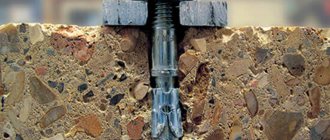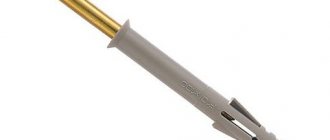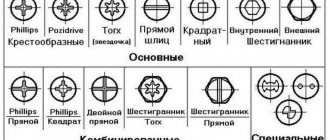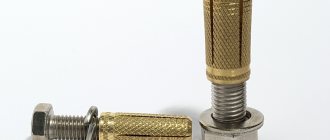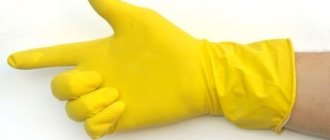When building a house or renovating an apartment, there is often a need to secure some heavy objects, be it a water heater for the bathroom, a wall unit for a child's room, or a china cabinet. And at the same time, a margin of safety is required.
Ordinary dowels with plastic spacers cannot always help in this matter; “heavy artillery” is needed here - these are anchors.
An anchor (“anchor” in German) is a bolt with a thread and a nut; the kit also includes a spacer part; such fasteners are designed for attaching weighty structures. From the photographs you can understand the features of the anchors, as well as their scope of application.
The history of the development of this fastener dates back to 1973, when a German council of experts began working on the calculation of permissible anchor fastenings. And in 1998, the regulation on the use of metal anchors in concrete ETAG 001 was issued.
In addition to solving household repair issues, anchor bolts are used in the construction industry; therefore, there are many types of anchors, from simple ones - created for fixed structures, to specific ones - solving issues of constant pressure and bending on the fastening element.
Advantages and disadvantages of anchor connections
Disadvantages include:
- Expensive cost;
- A lot of installation tools are required (puncher, hammer, screwdriver, wrench);
Advantages:
- Increased safety margin;
- Copes with pull-out loads;
- Long service life;
- Increased level of security.
An important characteristic of anchors is the material of manufacture. Only high-quality structural steel is used to make anchors or durable aluminum-based alloys.
The material used to make anchors must withstand loads and deformations. In addition, resistance to corrosion is an important quality, because anchor connections last for decades, so brass, aluminum and stainless steel are used, which do not rust.
When installing anchors in wet rooms, you should choose them with a thicker galvanized layer.
Basic designs of mechanical anchors
According to their design, mechanical anchors are also divided into the following main types.
Bolt and nut
The simplest type of spacer fastener, which is a rod (bolt) with a conical end, a sleeve with four cutouts and a nut. The nut acts as a lock - with its help the structure is fixed in a pre-drilled mounting hole, the diameter of which is equal to the diameter of the sleeve. After driving the rod into the hole, the nut is turned clockwise, thereby moving the rod outward. The tapered end of the pin expands the sleeve in the area of the cutouts, thereby securing the structure in the hole.
Anchor bolts are available in various sizes: the diameter of the rod is from 6 to 28 mm, the length is from 60 to 300 mm. Anchor bolts are used when working with dense materials (concrete, brick, stone).
Bolt with ring
Ceiling anchor, usually used for attaching lamps, chandeliers to the ceiling, cables, electrical cables, suspended ceilings, etc. Fasteners of this type, as an exception, can also be used on walls.
The only difference between such a fastener and an anchor bolt with a nut is that its outer end ends with an eyelet, which is necessary for hanging a hinged device or product. Fastening of such a structure is carried out in a similar manner: the fixing nut, located directly behind the end in the form of a ring, allows you to open and fix the sleeve in the hole.
Hook bolt
A fastener in the form of a bolt having a hook-shaped head. Used for fastening heavy structures to solid concrete, stone or brick foundations. The principle of fastening is similar to other connections in the form of a bolt with a nut - after tightening the fixing nut, the sleeve is deformed and secured in the drilled hole.
Hex Bolt
An anchor of this type is analogous to a bolt with a nut, but here a standard bolt is used instead of a rod (stud) and nut. When the bolt is tightened with a wrench, the tapered end deforms the sleeve, thereby filling the walls of the hole and securing the structure in it. Also available in a screwdriver version.
Double-spacer
Double Expansion Mechanical Anchors - Another expansion bolt and nut. The difference is that the design uses two sleeves (bushings, couplings) - short and long. The short one goes inside the long one with its cone-shaped end. When the nut is screwed in, the short sleeve expands with the cone-shaped end of the rod and, in turn, expands the long sleeve. Double-expansion anchors can also have a ring or hook end. Anchors of this design are used to increase the reliability of fastening.
Nails
Nail-type anchors are used when working with brick, concrete and stone foundations and are intended for fastening lightweight structures. They have the shape of a hollow nail, inside of which a wedging element is placed. The anchor is driven into the hole manually or using a power tool.
Expansion anchors
Expansion anchors are more often used for fastening heavy structures (metal doors). These are metal cylindrical bushings with grooves on the body. When the nut is tightened with a wrench, the bushing expands over the entire surface and rests closely against the base material.
The advantage of these anchors is their ability to withstand heavy loads in the perpendicular and longitudinal directions.
Classifications
Anchors are classified according to service life:
- Permanent.
- Temporary.
By size, fasteners are divided into:
- Small (up to 5.5 cm long and up to 0.8 mm in diameter).
- Medium (up to 12 cm long and up to 1.2 cm in diameter).
- Large (up to 22 cm long and up to 2.4 cm in diameter).
According to the base material, anchors are distinguished:
- For dense concrete, brick or stone materials.
- For hollow brick and concrete foundations.
- For sheet materials - plasterboard, chipboard and fibreboard.
According to the method of fastening, the following are distinguished:
- Mechanical
Fastening is carried out due to the direct mechanical effect of the working part of the anchor on the base (wedging, friction, stop, material resistance, etc.).
- Chemical
Additionally, a gluing mechanism (force) is used; for fastening, adhesive based on polyester resins is used.
What anchor do you use?
ChemicalMechanical
Mechanical anchors according to the technique of insertion into the base are divided into the following types:
- Wedges.
- Spacers.
- Hammers.
- Screw.
- Bushings.
- Expandable.
- Spring.
Spacers
Expansion anchors are a classic type of this type of fastener. They are a rod in the form of a bolt or pin with a cone-shaped end and an external element in the form of a sleeve, bushing or spring ring. The conical element, under the influence of the translational movement of the rod, expands the sleeve and secures the structure in the base.
Expanding
An expansion anchor consists of a threaded rod, which can be a bolt, stud or screw, and a sleeve consisting of 4 longitudinal petals with a spring ring and a cone nut on one side. When the rod rotates, the cone nut unclenches the sleeve petals, as a result of which the anchor expands and is secured in the base due to friction.
Wedge
Wedge fasteners are a long rod, at the end of which there is a deformation sleeve. After screwing the rod into the drilled hole, the sleeve petals expand. This type of fastener can withstand heavy loads.
Spring
Spring anchors are used when working with thin-walled bases, for example, when arranging the interior. Often, spring anchors are used as ceiling anchors and are equipped with a hook. The anchor is secured by unrolling the spring.
Screw
Screw anchors, or Molly bolts, are used when working with hollow structures with low load-bearing capacity - hollow brick, plasterboard, particleboard and fiberboard, etc. The Molly bolt is equipped with a special collet, which, when the bolt is tightened, opens and rests against material on the reverse side.
Bushing
Sleeve-type anchors consist of 3 or more elements, the main one of which is the collet - a spring split sleeve. The sleeve anchor design also includes a riving element and a threaded rod. When the anchor is twisted, the wedging element enters the collet and pushes it apart, thereby securing the fastener to the base.
Drivers
The basis of the driven anchor is a metal deformation sleeve with a conical hole, cuts in the body and internal threads. A firing pin is installed at the bottom of the sleeve. The sleeve is installed into the drilled hole manually or using an air gun. When the outer end of the sleeve is struck, it is deformed, after which a bolt or pin is screwed into the sleeve, necessary for fastening any object.
Fasteners for hollow materials
Double-expansion anchors are metal products consisting of steel bushings mounted on a stud. When tightening the nut on the outside, the bushings located inside diverge, the sleeve is deformed over the entire surface, because The bushings diverge in different spacer zones, which ensures reliable fixation in the wall; anchors of this type are almost impossible to remove after installation.
“Butterfly” anchors with an expansion mechanism are suitable for lightweight structures; they are used to fasten interior parts (pictures, sconces, shelves) to flat materials no thinner than 10 mm (plasterboard, chipboard, plywood).
The “wings” of the anchor open and are tightly fixed on the back side of the material. The reliability of the assembly depends on the base into which the anchor is screwed.
When choosing anchor products, it is necessary to take into account: the characteristics of the material of both the anchor and the base surface, the weight of the fixed equipment, installation principles and, of course, stock up on the necessary tools.
The design of anchors, unlike other fastening connections
A classic anchor is a combined metal structure consisting of a non-expandable (body or base) and an expansion (working) part. The base can be a bolt, screw, pin or nail, the spacer part can be in the form of a sleeve, cone, sleeve, etc. When using a fastener, the working part expands and, due to friction and resistance of the material, holds the structure in the base material.
The main difference between an anchor and a dowel that is similar in design and purpose is the material of manufacture. A dowel consists of a soft part, usually plastic, in which a fastening element, for example a self-tapping screw, is fixed. The principle of fastening the dowel is based solely on the frictional force between the working surface of the fastening joint and the base.
Since the anchor is usually made of alloy steel or other metals (brass, aluminum), its fastening principle is based not only on friction between the main and working parts, but also on the resistance of the material. Anchors are able to withstand more severe dynamic loads than fastening joints using dowels.
Wedge anchor - how to attach
This type can be considered as a modification of the previous one. The coupling is made in the form of a movable short sleeve-ring at the end of the pin on the shank (wedge) side.
Wedge pin anchor
The principle of operation is similar, there is a slight difference - it does not require precise drilling to the depth of the hole and cleaning it from dust. The hole is drilled with reserve, the anchor is inserted to the required depth and the nut is screwed in, pushing the sleeve apart with the shank.
Anchor bolt installation technology
First of all, depending on the thickness of the base and the weight of the structure being strengthened, the size and length of the anchor fasteners are selected.
Drill a hole in the base. The bushing should fit with interference. The depth is made slightly greater than the length of the sleeve.
Attention! After drilling is done, thoroughly clean the hole from any remaining base, crumbs, etc.
An anchor is installed in the hole, after which the structure is assembled. Installation must be done with light hammer blows. The force applied when twisting should gradually increase. Don’t “overdo it”: the anchor should hold firmly, but not destroy the base material.
Anchor fastening types and features of anchors application tightening technique
Using a kit for fastening to anchor supports, it is possible to install the coupling on power transmission line supports and wind the free length of the optical cable onto the frame. This type of connection is used to ensure the safety of work performed at height according to the permit. To carry out such activities, a permit is required, issued by a labor protection specialist and endorsed by officials from among the managers, and the work itself is carried out by a group of workers under the guidance of foremen and supervisors.
The most widely used are anchor bolts that have a spacer operating principle based on the expansion of the rear section of the sleeve when a cone-shaped sleeve is screwed into it. Among the well-known types of anchors, experts call driven, expanding, chemical, expansion and wedge structures. Each of them ensures reliable retention of the fastening part due to the use of the friction force between the contact surfaces of the bolt and the installation area, the thrust force, which ensures compensation of the effective stress by the resistance of the metal of the product. Increasing the diameter of the spacer sleeve when screwing a bolt into it ensures a reliable connection due to the combined action of thrust and friction forces.
Experts emphasize the importance of choosing the right type of anchor, based on studying the manufacturer’s documents that determine the specifics of each type of product. since the reliability of the system largely depends on the building material used at the point where the bolt is attached. Proper execution of fastening is necessary to prevent damage during operation of the parts that make up the connection and to ensure comfortable work in the support. Such a connection will ensure safety when working at heights, fastening heavy static (horizontal bars) and dynamic (diamond drilling rigs) structures.
How is a collet bolt classified by application?
Anchor-type fasteners are used to fix:
- window and door frames;
- household electrical equipment;
- flights of stairs;
- suspended ceilings;
- engineering communications;
- steel structures.
Fasteners are also used for the following purposes:
- fixing the metal frame in the foundation;
- ensuring reliable fastening with cellular building materials;
- fastening massive structures to concrete and stone walls;
- remote installation through a thick layer of thermal insulation material or decorative finishing to the facade surface.
For each application, you can always choose the optimal type of fastener.
Collet bolt is used when fastening flights of stairs
General recommendations
In order to correctly install anchor bolts, it is necessary to take into account the type and strength of the base, select the optimal type of anchor for a particular part and determine its load capacity.
And although some types do not require high precision hole drilling (for example, expanding), the more accurate it is, the more reliable the anchor’s adhesion to the base.
Information to note : Liquid glass , Solvent 646, white spirit.
Anchor bolt. Installation, principle of operation.

